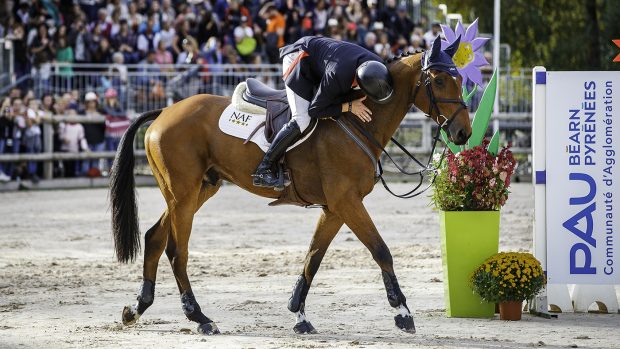Andrew Nicholson revealed several training secrets at the International Eventing Forum on Monday, 2 February. They included this handy exercise that every rider can do at home — with surprising benefits
The exercise:
Four small uprights (approximately 2ft high) on a 20m circle.
What it’s good for:
- Testing how alert a rider is
- Rider balance
- Teaching a horse to think for himself
- Learning to jump efficiently
“I don’t want my horses to balloon over fences because then they will go cross-country and scare themselves by going too high,” explains Andrew. “This exercise teaches horses to pop. Usually a small cross-country fence means there is a drop behind it, and they need to be able to pop that.”
None of the uprights have a ground line because, according to Andrew, it makes it less complicated.
“Horses can get deep to a single pole and learn to do a slithery jump, like they need to at a coffin,” adds Andrew. “I don’t use cross-poles because they have to be jumped in the centre, whereas uprights can be jumped to the left or right to help make the distance.”
Andrew said that this exercise is the nearest he gets to not looking for a stride. He looks for a stride to the first upright, but then focuses only on riding the canter. He demonstrates this by turning his head to look at the audience, as his horse continues on the circle.
“A lot of people think I ride as fast as I can and take whatever stride I’ve got, but I’m really the opposite. The smoother you are to a fence, the less energy the horse is wasting.”
Andrew did this exercise on two Spanish-bred five-year-olds.
“All I do is ride the canter. The horse has to sort the rhythm and the distance,” explained Andrew.
Both horses make mistakes on the first loop and poles fall to the ground. But as they learn the exercise, they correctly judge the distance.
After 20mins each, the horses finish their sessions.
“I have a lot of horses to ride each day, especially at this time of year, so what I do with each one has to be quick. This exercise is hard work because they have to keep pushing with their hindleg, and they are learning.”
- Next year’s International Eventing Forum will take place at Hartpury College on 1 February 2016
Pictures courtesy of Jon Stroud Media





